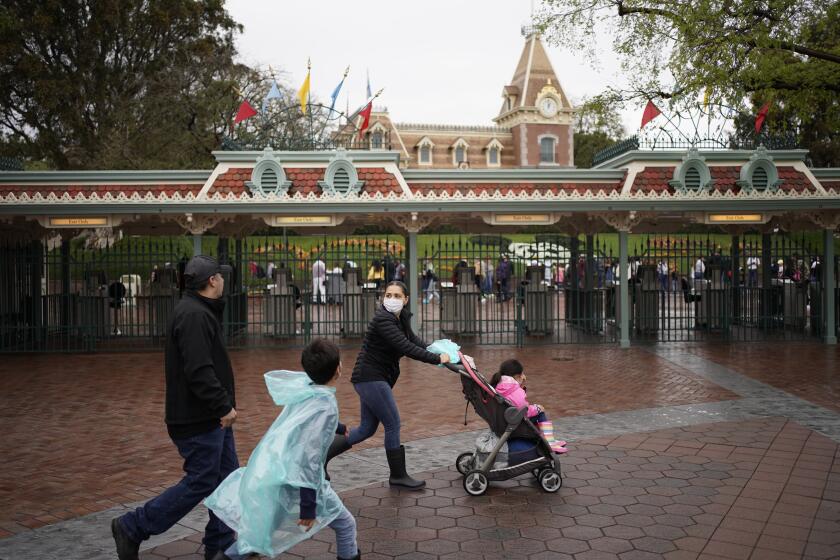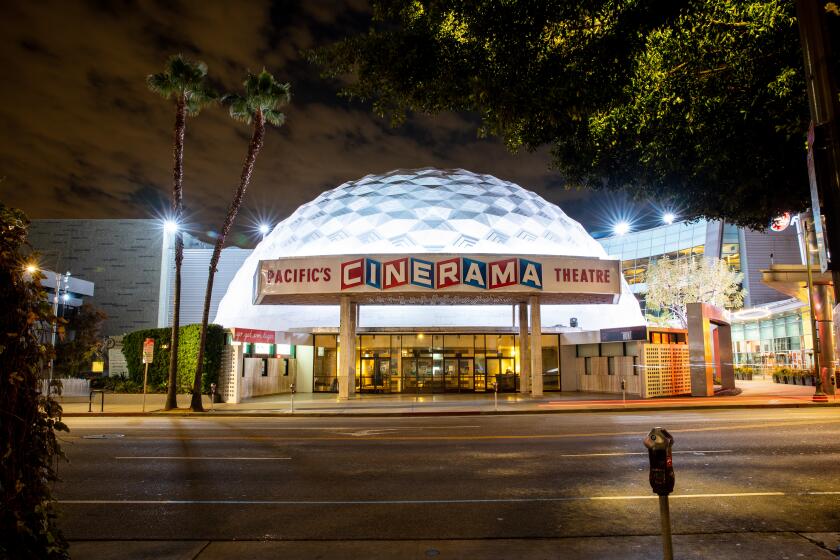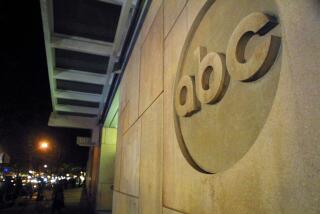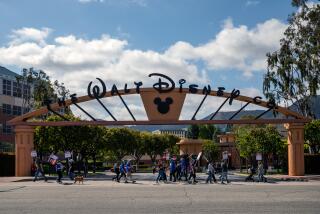After coronavirus and 100,000 furloughs, where does Disney go from here?
Walt Disney Co. has long treated its parks workforce like an extended family, calling them “cast members” to emphasize their importance to the team.
That’s one reason why the company’s decision to furlough more than 100,000 employees amid the coronavirus crisis has become one of the most visible signs of the economic devastation from COVID-19.
The pandemic has effectively grounded much of the Burbank entertainment colossus, which until recently was riding high on its dominant box office performance, packed themed parks and a fast-growing new streaming service.
Since the outbreak, its resorts have been shuttered, its blockbuster productions have stalled, and there have been no live sports for cable channel ESPN to cover. The company has taken on billions of dollars in debt and slashed executive compensation to blunt the pain. Executive Chairman Bob Iger decided to forgo his base salary, and the company’s new chief executive, Bob Chapek, saw his base pay fall by 50%.
Analysts say the problems could be long-lasting. “We fear that the uncertainty of the present situation creates significant and unrivaled” risk to Disney’s earnings “for the foreseeable future,” wrote media analyst Michael Nathanson in a Monday research report. On Monday he downgraded Disney’s share price from buy to “neutral.”
The cuts at Disney, the world’s largest entertainment company and one of California’s biggest private employers, represent nearly half of the company’s global workforce of 223,000 people. The company pledged to continue paying healthcare benefits during the furlough period.
Disney’s stock has taken a dive due to the coronavirus outbreak that has shuttered parks and delayed major film releases.
The shutdowns could have serious implications for California’s economy because of the number of people temporarily out of work and the amount of economic activity the parks attract to the area. Researchers at Cal State Fullerton estimate that Disneyland Resort contributes $8.5 billion to Southern California’s economy a year.
It remains unclear how long the Anaheim parks will remain closed. California Gov. Gavin Newsom said it would be “months, not weeks” before entertainment attractions could reopen. Because of the uncertainty surrounding when the pandemic will end, some analysts think it’s unlikely Disneyland and other parks will reopen until 2021.
“What’s proving to be the case is that none of this is going to be simple,” said Kevin Klowden, executive director of the Milken Institute’s Center for Regional Economics and California Center. “That puts a tremendous amount of pressure up and down the company and also on the California economy.”
Disney declined to comment for this story.
The crisis has also raised long-term questions about what Disney will look like when the virus subsides. Iger last month told business publication Barron’s that he didn’t “think we’re ever going to see a return to business as usual.” He added that the company would “look for ways to run our businesses more efficiently when we come back.”
What Iger meant by that will probably be on the minds of analysts tuning in to Disney’s quarterly earnings call on Tuesday.
Photos capture Hollywood’s movie houses in this pandemic moment.
“[Iger] was very non-specific as far as what he had in mind,” said Cowen & Co. analyst Doug Creutz. “I think the question is, ‘When are these people coming back?’ and their answer is going to be, ‘We don’t really know.’”
Earnings for the company’s second fiscal quarter will give Wall Street an idea of the damage to Disney so far, though they account for less than a month of domestic park closures.
Analysts on average expect second quarter earnings per share of 91 cents, down 43% from the same period of time a year ago, according to FactSet. Nathanson estimated that full-year profits (excluding certain items) will fall 66% to $1.5 billion at the parks segment for fiscal 2020.
Like most other media companies, Disney’s stock has taken a drubbing during the pandemic. The stock, which closed at $103.18 on Monday, has fallen 29% so far this year.
The vast majority of the furloughs come from Disney’s parks, experiences and products segment, which employs 177,000 people, including workers at its retail stores and four cruise ships. An estimated 31,000 work at Disneyland Resort. Walt Disney World employs more than 70,000 in Florida, making it one of the state’s biggest job sources. Disneyland Paris is estimated to employ 17,000.
Although Disney has not disclosed any figures, furloughs and other cost-saving measures could save the company an estimated $500 million a month, according to JP Morgan analyst Alexia Quadrani.
Chris Duarte, president of Workers United, Local 50, which represents about 7,650 Disney food and beverage workers at Disneyland, said the furloughs will be tough on staffers, many of whom are filing for expanded unemployment benefits.
However, he said the union was pleased to retain health benefits for its members. Disney also agreed with labor unions to hire back workers based on the seniority rules in the workers’ contracts.
“Our main goal was to ensure benefits for our members,” Duarte said.
It’s an anxiety-inducing time for people like Glynndana Shevlin, 60, who has worked at the Disneyland Hotel for 28 years as a food concierge and a wine server. Shelvin, single and living in a studio apartment in La Mirada, said she is anxious about the future as she waits to collect unemployment benefits to help her pay her bills until the resort reopens. “This is nerve-racking,” she said. “So far, I’m doing OK.”
The furloughs have also spread to Disney’s movie studio, which has suffered from the closure of movie theaters, the delay of releases such as “Mulan,” and the pause of film shoots including a live-action remake of “The Little Mermaid.” Cuts have affected people in distribution, marketing, publicity and production, according to people familiar with the matter who were not authorized to comment.
ESPN has been pummeled by the shutdown, losing much of its main draw, live sports, which require large production crews who are now idle. The network has furloughed production crews for live sporting events.
Disney TV staffers in Burbank have been spared from furloughs, and crew members on shows that halted production were sent home with three weeks’ pay. More trouble could come to the company’s TV division if a recession leads to a prolonged drop in advertising revenue and an acceleration in cord-cutting.
The company’s growing streaming empire also avoided furloughs. Disney’s new streaming service Disney+ has been a bright spot as coronavirus-related closures keep viewers glued to their phones and TV screens. Disney recently said the $6.99-a-month streamer had passed 50 million subscribers in five months after launching in western Europe and India.
Disney paid parks workers for five weeks of closures.
“They tried to keep people on the payroll as long as they could reasonably afford to,” said David Heger, an analyst at Edward Jones who has a “buy” rating on Disney’s stock. “Ultimately when you have parks shut down and a lot of operations not running, it’s hard to justify keeping that level of costs. Right now, Disney kind of has to go into conservation mode.”
People who follow Disney closely don’t expect the company to lose its position as the entertainment industry’s powerhouse, but how long it will take for it to recover is unclear, especially at the parks.
Anil Puri, an economics professor at Cal State Fullerton and director of its Woods Center for Economic Analysis and Forecasting, said he expects Disneyland to eventually return to strength.
However, the company will have to come up with measures to apply social distancing and enhanced sanitation standards in the parks to minimize the transmission of the virus. That could mean checking guests for fevers at the gates and limiting capacity for a period of time.
“It’s going to be a slow process,” Puri said. “Everywhere you go, you’re very close to people, standing in line, going through turnstiles. It will be difficult.”
Laurinda Fiddler, 58, a retail worker at Disneyland Resort, where she’s worked since 1984, said the furlough came at an awkward time. She was in the process of selling her home in Moreno Valley to buy a bigger home so she can move in her elderly mother from Colorado. Without an income, she can’t qualify for a home loan.
While she agreed the union worked out a good deal with Disney, Fiddler is looking for other jobs as she applies for unemployment benefits. “I’m open to what happens,” she said.
More to Read
Inside the business of entertainment
The Wide Shot brings you news, analysis and insights on everything from streaming wars to production — and what it all means for the future.
You may occasionally receive promotional content from the Los Angeles Times.















